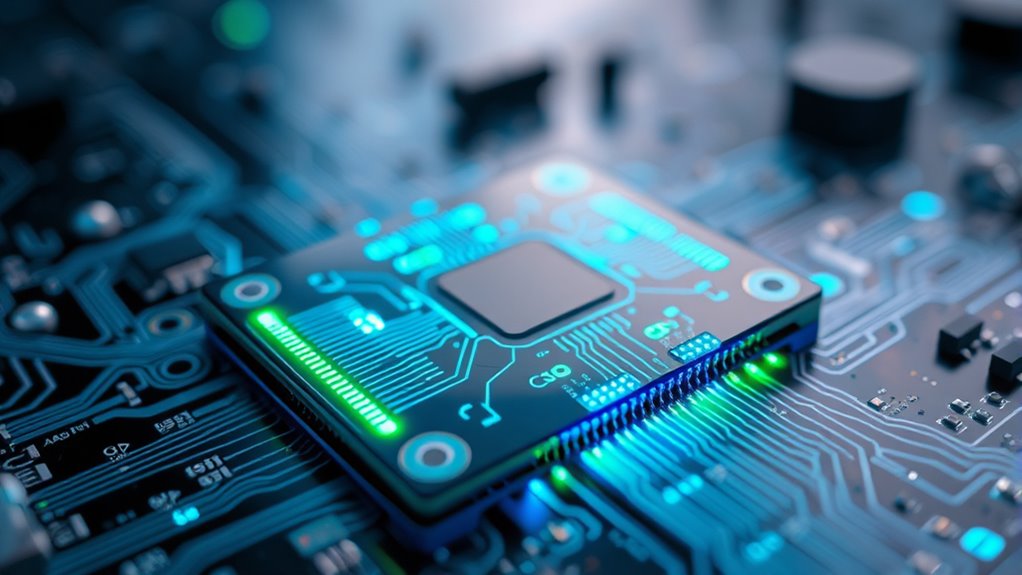Imagine the ingenuity of the human brain compressed into a tiny chip—sounds like science fiction, right? Neuromorphic chips are making this a reality by mimicking how our brains process information. These silicon-based systems are revolutionizing computing, offering energy efficiency and adaptive learning capabilities. As they evolve, they could reshape AI, robotics, and sensory technology in ways we’ve only begun to explore. The question is, how far can this brain-inspired innovation go?
Key Takeaways
- Neuromorphic chips replicate brain architecture to process information more naturally and efficiently.
- They use spike-based communication, enabling low-power operation suitable for real-time tasks.
- These chips can learn and adapt dynamically, enhancing robustness and flexibility in AI applications.
- They excel in perception tasks like image recognition and speech understanding, advancing AI cognition.
- Neuromorphic technology addresses AI security concerns by improving system resilience and trustworthiness.

Neuromorphic chips are revolutionizing the way computers process information by mimicking the structure and function of the human brain. They employ a brain inspired architecture that closely resembles neural networks in your brain, allowing machines to perform complex tasks with remarkable efficiency. Unlike traditional chips that rely on linear, sequential processing, neuromorphic chips are designed to handle multiple operations simultaneously, much like neurons firing in your brain. This design enables them to process data in a way that’s more natural and adaptable, opening doors to advancements in artificial intelligence, robotics, and sensory processing.
One of the key advantages of neuromorphic chips is their energy efficient processing. Traditional processors consume significant power, especially when handling large-scale computations or real-time data streams. Neuromorphic chips, however, are built to operate with minimal energy by leveraging their brain inspired architecture. They use spike-based communication, where signals are transmitted only when necessary, reducing unnecessary energy expenditure. This means you can run sophisticated AI applications on devices with limited power sources, like drones, wearables, or autonomous sensors, without sacrificing performance or battery life.
Neuromorphic chips use spike-based communication for ultra-efficient, low-power AI processing on small devices.
The brain inspired architecture of neuromorphic chips also grants them a level of robustness and adaptability that traditional chips struggle to match. Your brain constantly rewires itself, learning from new experiences and adapting to changing environments. Similarly, neuromorphic systems can learn and adapt on the fly, improving their functionality over time without needing extensive reprogramming. This flexibility is vital for applications like real-time decision-making, pattern recognition, and sensory data interpretation.
Furthermore, because neuromorphic chips process information in a manner similar to biological brains, they excel at tasks that involve perception and cognition. They can recognize images, understand speech, and interpret sensory inputs more efficiently than conventional processors. This capability makes them ideal for developing smarter robots, more intuitive AI assistants, and advanced prosthetics that can seamlessly integrate with human sensory systems.
Recent research also suggests that neuromorphic chips can play a pivotal role in addressing AI security concerns, such as robustness against adversarial attacks and improving trustworthiness in AI systems.
Conclusion
As you explore neuromorphic chips, remember they’re like a symphony of silicon, harmonizing brain-inspired design with cutting-edge technology. Their ability to learn, adapt, and process information naturally makes them a revolution in computing—transforming machines into minds that think and react more like us. Embracing this evolution, you’ll see a future where technology isn’t just smart but truly alive, echoing the intricate beauty of the human brain in every silicon neuron.









